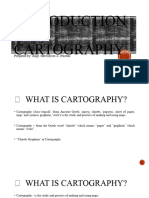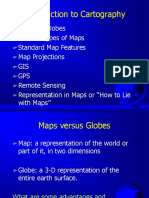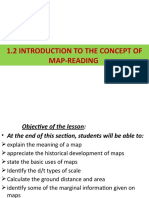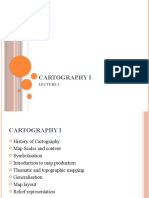0% found this document useful (0 votes)
137 views46 pagesLEC 1a - Introduction To Cartography - v1
This document provides an introduction to cartography. It defines cartography as the study and practice of making maps. The key aspects of cartography discussed are its purpose of communicating geospatial information through maps, the different types of maps classified by scale and function, and basic map characteristics such as projections, scale, and generalizations. Map projections transform the spherical Earth into flat maps, and all maps introduce some distortion of shape, size, direction or distance. Maps are categorized by scale as small or large scale, and by function as general reference, topographic, or thematic maps.
Uploaded by
Haziq ZahiruddinCopyright
© © All Rights Reserved
We take content rights seriously. If you suspect this is your content, claim it here.
Available Formats
Download as PDF, TXT or read online on Scribd
0% found this document useful (0 votes)
137 views46 pagesLEC 1a - Introduction To Cartography - v1
This document provides an introduction to cartography. It defines cartography as the study and practice of making maps. The key aspects of cartography discussed are its purpose of communicating geospatial information through maps, the different types of maps classified by scale and function, and basic map characteristics such as projections, scale, and generalizations. Map projections transform the spherical Earth into flat maps, and all maps introduce some distortion of shape, size, direction or distance. Maps are categorized by scale as small or large scale, and by function as general reference, topographic, or thematic maps.
Uploaded by
Haziq ZahiruddinCopyright
© © All Rights Reserved
We take content rights seriously. If you suspect this is your content, claim it here.
Available Formats
Download as PDF, TXT or read online on Scribd
/ 46


















































































